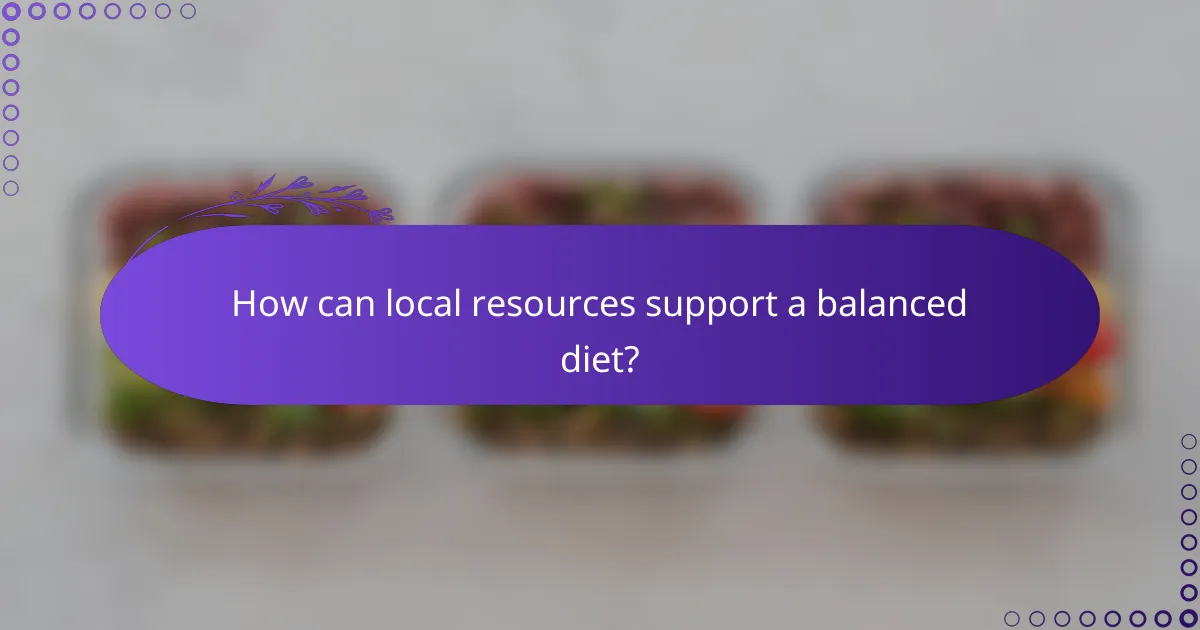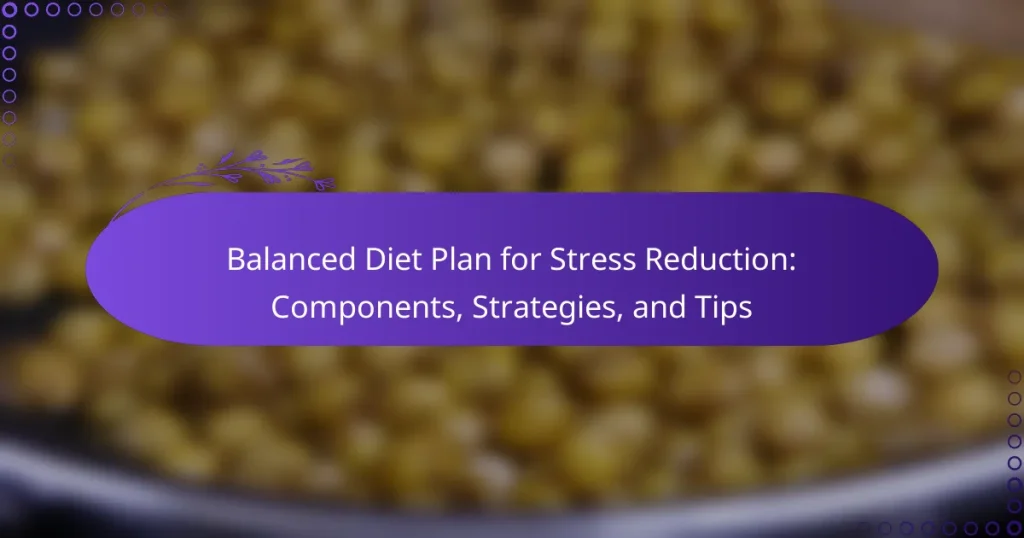A balanced diet plays a vital role in stress reduction by supplying essential nutrients that enhance brain function and emotional stability. Incorporating a variety of foods such as fruits, vegetables, whole grains, and lean proteins can help regulate hormones and neurotransmitters, ultimately leading to lower stress levels and improved mood.

How can a balanced diet reduce stress?
A balanced diet can significantly reduce stress by providing essential nutrients that support brain function and emotional well-being. Proper nutrition helps regulate hormones and neurotransmitters, which are crucial for managing stress levels effectively.
Impact of nutrients on mood
Nutrients play a vital role in influencing mood and emotional health. For example, omega-3 fatty acids found in fish and flaxseeds can help reduce anxiety and depression. Similarly, B vitamins, particularly B6, B12, and folate, are essential for the production of neurotransmitters like serotonin, which regulate mood.
Incorporating a variety of fruits, vegetables, whole grains, and lean proteins into your diet can ensure you receive a broad spectrum of these mood-enhancing nutrients. Aim for colorful plates, as different colors often represent different beneficial compounds.
Role of hydration in stress management
Staying hydrated is crucial for maintaining optimal brain function and reducing stress. Dehydration can lead to fatigue, irritability, and difficulty concentrating, all of which can exacerbate stress levels. Aim to drink at least 2 liters of water daily, adjusting for activity levels and climate.
Incorporating hydrating foods like cucumbers, oranges, and soups can also contribute to your daily fluid intake. Monitor your hydration by checking the color of your urine; pale yellow indicates proper hydration, while dark yellow suggests a need for more fluids.
Benefits of regular meal timing
Eating at consistent times throughout the day helps regulate your body’s internal clock, which can improve mood and energy levels. Skipping meals or irregular eating patterns can lead to blood sugar fluctuations, contributing to stress and irritability. Aim for three balanced meals with healthy snacks in between.
Establishing a routine can also create a sense of stability, which is beneficial during stressful times. Consider setting reminders for meal times and planning meals ahead to avoid last-minute unhealthy choices.

What are the key components of a balanced diet for stress relief?
A balanced diet for stress relief includes a variety of foods that support mental health and emotional well-being. Key components include fruits, vegetables, whole grains, and lean proteins, all of which contribute to reducing stress levels and enhancing mood.
Fruits and vegetables for antioxidants
Fruits and vegetables are rich in antioxidants, which help combat oxidative stress in the body. Foods like berries, spinach, and citrus fruits are particularly beneficial, as they contain high levels of vitamins C and E, which can lower cortisol levels, a hormone associated with stress.
Incorporating a colorful variety of produce into your meals can maximize antioxidant intake. Aim for at least five servings of fruits and vegetables daily, focusing on those that are in season for better taste and nutritional value.
Whole grains for sustained energy
Whole grains, such as brown rice, quinoa, and oats, provide complex carbohydrates that release energy slowly. This steady energy supply helps maintain stable blood sugar levels, which is crucial for managing stress and preventing mood swings.
Consider replacing refined grains with whole grains in your diet. For example, choose whole grain bread instead of white bread and opt for whole grain pasta. Aiming for three to five servings of whole grains each day can support overall energy levels.
Lean proteins for neurotransmitter support
Lean proteins, including chicken, fish, beans, and legumes, are essential for producing neurotransmitters that regulate mood. Foods rich in omega-3 fatty acids, like salmon and walnuts, can particularly enhance brain function and reduce anxiety.
Incorporate a source of lean protein in every meal to support neurotransmitter production. Aim for two to three servings of lean protein daily, and consider plant-based options for variety and additional health benefits.

Which foods should be included in a stress-reducing diet?
A stress-reducing diet should include foods that promote overall well-being and support mental health. Key components include omega-3 rich foods, fermented items for gut health, and healthy fats from nuts and seeds.
Omega-3 rich foods like salmon
Incorporating these fish into your diet a few times a week can provide significant benefits. If you prefer plant-based options, consider flaxseeds, chia seeds, and walnuts as alternatives.
Fermented foods for gut health
Fermented foods, such as yogurt, kefir, sauerkraut, and kimchi, are beneficial for gut health and can positively influence mood and stress levels. These foods contain probiotics that support a healthy microbiome, which is linked to mental well-being.
Including a serving of fermented foods daily can enhance your digestive health and may help in managing stress. Look for options that contain live cultures for maximum benefits.
Nuts and seeds for healthy fats
Nuts and seeds are rich in healthy fats, vitamins, and minerals that contribute to stress reduction. Almonds, walnuts, sunflower seeds, and pumpkin seeds are particularly beneficial due to their nutrient profiles.
Snacking on a small handful of nuts or seeds can provide a quick energy boost and help stabilize blood sugar levels, which is important for managing stress. Aim for a variety of these foods to ensure a broad spectrum of nutrients.

What strategies can enhance a balanced diet for stress reduction?
Strategies that enhance a balanced diet for stress reduction focus on consistency, mindfulness, and variety. Implementing these approaches can help maintain nutritional balance while effectively managing stress levels.
Meal prepping for consistency
Meal prepping involves planning and preparing meals in advance, which can lead to healthier eating habits and reduced stress. By dedicating a few hours each week to cook and portion meals, you can ensure you have nutritious options readily available, minimizing the temptation to opt for unhealthy choices.
To start meal prepping, choose a day to cook several meals at once. Consider using containers to portion out meals for the week, focusing on balanced components like lean proteins, whole grains, and plenty of vegetables. This strategy can save time and help you stick to your dietary goals.
Mindful eating practices
Mindful eating encourages awareness of the eating experience, which can help reduce stress and improve digestion. By focusing on the flavors, textures, and aromas of food, you can cultivate a deeper appreciation for your meals and recognize hunger and fullness cues more effectively.
To practice mindful eating, eliminate distractions during meals, such as screens or multitasking. Take your time to chew thoroughly and savor each bite, aiming to eat slowly and enjoy the process. This approach can lead to healthier choices and a more satisfying eating experience.
Incorporating variety to prevent boredom
Incorporating variety into your diet is essential for preventing boredom and ensuring you receive a wide range of nutrients. Eating a diverse array of foods can keep meals interesting and enjoyable, which is crucial for long-term adherence to a balanced diet.
To add variety, experiment with different fruits, vegetables, grains, and proteins each week. Consider trying new recipes or cuisines, and aim to include seasonal produce for freshness. This not only enhances flavor but also supports overall health by providing essential vitamins and minerals.

How can local resources support a balanced diet?
Local resources play a crucial role in supporting a balanced diet by providing access to fresh, nutritious foods and educational opportunities. Utilizing these resources can help individuals make healthier choices and reduce stress through better nutrition.
Farmers’ markets for fresh produce
Farmers’ markets offer a direct connection to local farmers, providing access to fresh fruits and vegetables. Shopping at these markets often means purchasing seasonal produce, which is typically more flavorful and nutritious.
To maximize benefits, visit farmers’ markets regularly, ideally once a week, to stock up on a variety of fresh items. Look for markets that accept local currency and check for any community programs that offer discounts or incentives for purchasing fresh produce.
Community-supported agriculture programs
Community-supported agriculture (CSA) programs allow individuals to buy shares in a local farm’s harvest. This model supports local agriculture while providing members with a regular supply of fresh produce throughout the growing season.
Joining a CSA can be a cost-effective way to access organic and sustainably grown foods. Typically, members receive a box of seasonal produce every week or bi-weekly, which encourages trying new recipes and ingredients.
Nutrition workshops in urban areas
Nutrition workshops in urban areas provide valuable education on healthy eating habits and meal planning. These workshops often cover topics such as understanding food labels, cooking techniques, and the importance of a balanced diet.
Participating in these workshops can enhance knowledge about nutrition and inspire individuals to make healthier food choices. Look for local community centers or health organizations that offer free or low-cost workshops to get started.

What are the common challenges in maintaining a balanced diet?
Maintaining a balanced diet can be difficult due to various challenges that many individuals face. These challenges often include time constraints, limited access to healthy food options, and cravings for unhealthy snacks.
Time constraints for meal preparation
Busy schedules can make it hard to find time for meal preparation, leading to reliance on quick, unhealthy options. Planning meals in advance can help mitigate this issue, allowing for the preparation of nutritious meals that can be stored and consumed later.
Consider dedicating a few hours each week to meal prep. Cooking in batches and utilizing simple recipes can save time during the week. Aim for meals that can be easily reheated or assembled, such as grain bowls or stir-fries.
Access to healthy food options
Limited access to healthy food options can hinder efforts to maintain a balanced diet, especially in food deserts where fresh produce is scarce. Exploring local farmers’ markets or community-supported agriculture (CSA) programs can provide access to fresh, nutritious foods.
Additionally, consider using grocery delivery services that focus on healthy options. When shopping, prioritize whole foods like fruits, vegetables, whole grains, and lean proteins, and try to avoid processed foods that are often less nutritious.
Overcoming cravings for unhealthy snacks
Cravings for unhealthy snacks can derail a balanced diet, often triggered by stress or boredom. To combat these cravings, it’s helpful to have healthy alternatives readily available, such as nuts, yogurt, or fruit.
Establishing a routine that includes regular meals and snacks can help stabilize blood sugar levels and reduce cravings. When cravings do occur, try to wait a few minutes before indulging; often, they will pass. If you choose to indulge, do so mindfully and in moderation.


